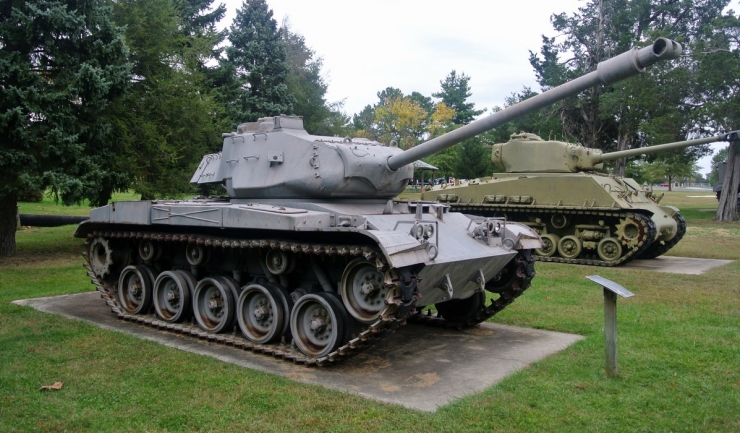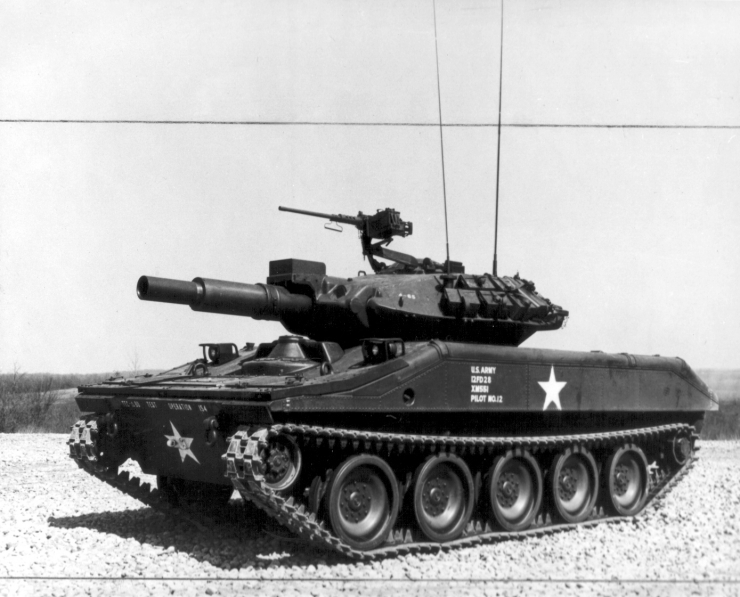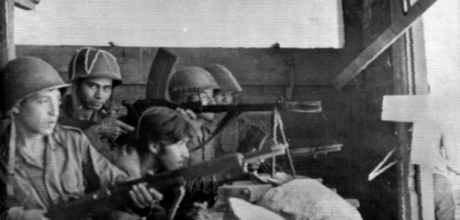The Sheridan lineage can be traced back to the M41 Walker Bulldog and the need to replace it. The Bulldog was a solid American light tank but as more and more Soviet heavier tanks started appearing in the American reports, it was clear that its 76mm gun was no longer capable of dealing with the newest Soviet medium tank threats.

The Walker Bulldog entered the service in 1953 but soon after, in 1954, the US Army started to develop and test its possible replacements. This request for proposals eventually ended with the T92 Light Tank, a 17 ton experimental vehicle, equipped with a 76mm high-power gun and a 340hp engine. It was tested a lot between 1956 and 1958 but ultimately the design was not successful. It had two major flaws – for one, it was under-gunned: the 76mm T185E1 gun was no longer considered sufficient to deal with the threats the vehicle might encounter. Second major flaw was that the vehicle was not amphibious and could not be modified to swim. This demand was heavily influenced by the appearance of the Soviet PT-76 tank and from that point onwards appeared repeatedly in both Soviet and American vehicle programs. Tactically however, it was and still is of dubious value and it is surprising that, given the trouble it caused to several notable designs, it wasn’t discarded earlier and in some forms stays around until today. The project was eventually abandoned, but the problems with insufficient firepower stayed.

In late 50’s, it was clear that any 76mm gun would no longer do because of the excellent frontal sloped armor of the Soviet designs. Even lighter vehicles needed something to fight of enemy armor (or so it was thought at that point) but the designers were simply not able to fit full-sized medium tank guns into the proposed light tank turrets – at least not without crippling the other vehicle properties. Additionally, 76mm guns had quite poor high-explosive capabilities, important for fighting enemy infantry. Alternative means to increase firepower were sought including both reasonable and ludicrous proposals but in the end, an unconventional solution presented itself that would heavily influence the design of the future US Army’s light tank.
Ever since 1958, the Philco Ford company was developing a new weapon system, consisting of the 152mm M81 gun-launcher, capable of firing MGM151 Shillelagh missiles. The entire launcher was very light since the charge needed to launch the missile was quite small and therefore there was no need to make the entire mechanism too sturdy. The recoil was very low as well, allowing this system to be used on a relatively light chassis. At that point, the Shillelagh HEAT warhead offered enough firepower to destroy any enemy vehicle it would encounter on the battlefield at any range (up to 4 kilometers), which meant that a light tank equipped with it could actually destroy enemy tanks at distances far beyond their gun ranges. The theoretical minimal range for the missile was somewhere between 75 and 100 meters with the minimal truly effective range being estimated at 1000 meters, but that was (at least in theory) not a problem as shootouts with enemy medium or heavy tanks at less than 1 kilometer were considered suicidal anyway.
But the missile was of course only effective against armored targets. The gun had to be capable of firing high explosive rounds as well – fortunately, that was not that big of a problem either. Considering HE shells need less muzzle velocity than anything else, it was completely fine to simply fire them with reduced charges, just like the missiles. The 152mm HE shells were slow but massive and utterly devastating to soft targets. Additionally, the shell casing was semi-combustible and only the rear part (the ring) was extracted upon firing, leading to the savings of precious space within a light vehicle turret - in theory at least.
When the gun was selected, the army started to look for something to put the gun on. As usual, the army had a contradictory set of demands that included:
- Frontal hull protection against Soviet 14,5mm shells
- Frontal turret protection against Soviet 20mm shells
- Amphibious capability
- Gas protection
- Night fighting capability
- Transportability by air
- Maximum mobility in terrain
There were a couple more demands and in the end, the Cadillac (GM) proposal looked the best. In addition to the project viability, Cadillac also had a tank production plant in Cleveland where 600 qualified workers were assembling the last of the Walker Bulldogs.
The Cadillac proposal was powered by a Detroit Diesel 6V-53T engine (the engine code means: 6 cylinders, V-shaped cylinder configuration, 53 is the volume of one cylinder in cubic inches and the T means “turbocharged”), which produced 300 horsepower at 2800 RPM. In order to keep the power-to-weight ratio at sufficient levels, the developers opted for aluminum hull armor instead of classic steel to save weight. The dimensions of the vehicle were further constrained by the maximum allowed dimensions that could be carried by army transport planes – unfortunately, this made it practically impossible for the vehicle to be amphibious “just so” (not enough displacement) – to achieve that objective, rubber floaters had to be added as well. In order to reduce the fire risk and to save some weight, hydraulic turret traverse was also sacrificed. The project received its designation “Armored Reconnaissance/Airborne Assault Vehicle” (AR/AAV) in 1960 and in 1961 the turret with the prototype 152mm XM81 gun was trialed on the M41 Walker Bulldog suspension (Shillelagh firing trials). The XM81 development was actually delayed as well due to the MBT-70 debacle and the Cleveland plant was actually under threat of closing for some time (the gap between M41 and future AR/AAV production) before it was saved by the contract to produce the M114 howitzers.
The army ordered six prototypes in 1960 – this vehicle was actually prepared very quickly since the project was by that point and the first prototype was ready later that year, arriving for driving tests at Fort Knox. Later on the number of ordered prototypes was increased from six to twelve and then to twenty.

The XM551 (as it was called already) was a completely new design, built from scratch – that caused some issues during the prototype assembly as every prototype was somewhat different since the designers and engineers improved the vehicle and fixed the flaws of some of its parts as they went – and yes, there were flaws, many flaws.
For starters, the engine cooling system was poor and the engine was constantly overheating. Some of the internal aluminum parts were very fragile and were breaking apart every now and then. Another constant source of issues was the wiring and the electronics in general and the XM81 gun was problematic as well to the point where (despite enormous amount of money invested already) it was seriously considered cancelling the entire XM551 project and switching the Cleveland assembly line to something else (possibly the M60 tanks). In the end the project supporters won, arguing that the entire project was already too expensive to simply abandon it – and that the US Army units were equipped with obsolete vehicles (which was true) and thus it would be wiser to just produce the XM551 and train the crews as the first tanks arrive at the designated units. One of the major reasons why the XM551 would eventually be mass-produced was also the tension in south-east Asia, resulting eventually in the Vietnam War – it was under those circumstances that the mass-production was approved in 1965. The vehicle however was far from ready and numerous flaws appeared almost immediately.
How that was dealt with is the story for the next part...








